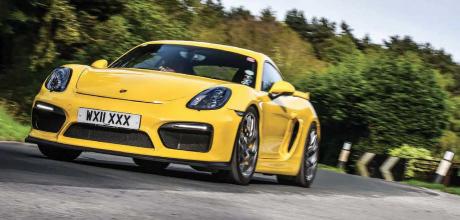425bhp Porsche Cayman GT4 981C
Bought new in autumn 2015 and subsequently treated to a wealth of engine and chassis upgrades, Chris Whittle’s 425bhp 981C Cayman GT4 proves the 911 shouldn’t be your defaultchoice when purchasing your next modern Porsche for fast-road fun and trackday heroism...
Words Dan Furr, Shane O’Donoghue, Chris Whittle
Photography Chris Wallbank
SCRAPPER’S DELIGHT
Chris Whittle’s 425bhp 981 Cayman GT4.
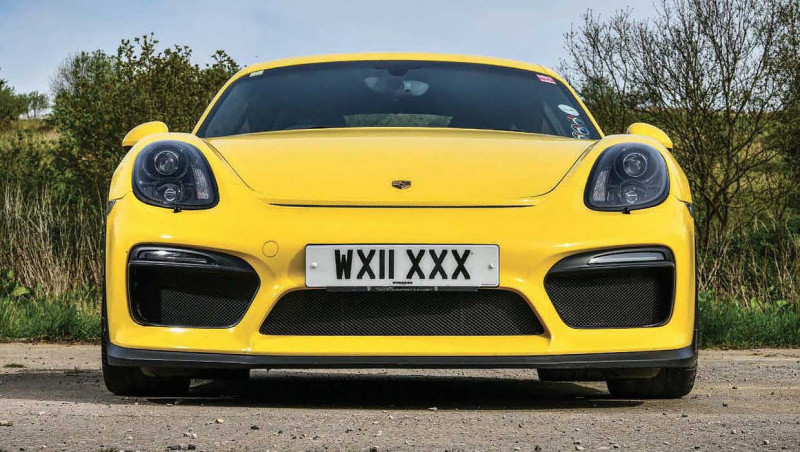
Progress is a funny thing. The human race is hellbent on advancing every facet of its existence, seemingly striving for absolute perfection in every aspect of our lives. While this drive to improve and refine applies to what we eat, when we sleep and how we exercise, it’s even more prevalent in the realm of developing technology. Yesterday’s rooms full of computing hardware, for example, were nowhere near as powerful as today’s tiny smartphone. In the world of cars, the pace of development has also been blisteringly quick, a trend encouraged by manufacturers working hard to ensure their new models are better equipped and safer than vehicles previously rolling off production lines.
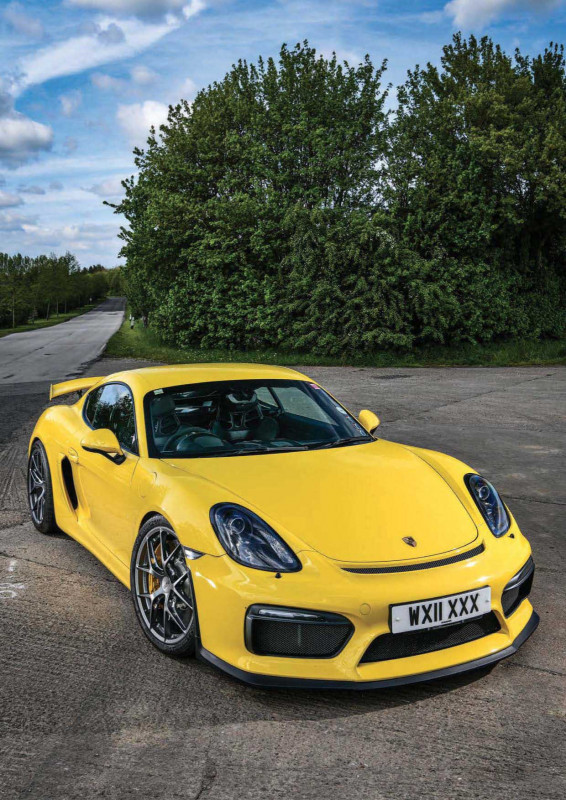
There’s also the drive to produce a more attractive proposition than what’s being assembled and marketed by the competition. In general, car makers deliver on these goals, but it’s all too easy for them to lose sight of maintaining an engaging driving experience, especially when it comes to sports machines. Even our beloved Porsche gets caught up in the need to further technological prowess, but at what cost?

With the introduction of the 718 in 2016 came what looked like the death knell for normally aspirated engines in the Boxster/Cayman line-up. Charismatic-sounding six-cylinder boxers free of forced induction were replaced by a duo of less-than-melodic turbocharged four-cylinder powerplants. Sure, they kick much harder in the mid-range and are, theoretically at least, more efficient, but as outlined across previous pages, it’s fair to say they weren’t met with widespread acceptance. Thankfully, Porsche hasn’t forgotten how to listen. Reacting swiftly, the company set about getting normally aspirated, six-cylinder power back into the mid-engined juniors of its product range. The result was the launch of the 718 Spyder and 718 Cayman GT4.
TAKE A LOOK AT THE BRAND’S MAJOR SUCCESSES AT THE RACE TRACK AND YOU’LL SEE MID-ENGINED MODELS REIGN SUPREME

Success was assured, although this came as little surprise to those of us who follow Porsche product development and subsequent reactions in the marketplace. We know only too well how the company massively underestimated demand for the 981-generation Cayman GT4, a 3.8-litre normally aspirated pocket rocket presenting sharp looks and rapid pace. The Cayman, so it seemed, was finally allowed to take the fight to the 911. And in the eyes of many true driving enthusiasts, the evergreen flagship was being beaten at its own game.
A SET OF TWENTY-INCH FI-Rs FOR THE 911 TURBO AND GT3 SHOWS SCALES TIPPING AT 7.9 KILOGRAMS FOR THE FRONT WHEELS AND 9.3 KILOS FOR THE REARS
Porsche knows the mid-engined layout delivers on the promise of extraordinarily good chassis dynamics. The company doesn’t shout about the following fact for fear of raising questions from buyers of production 911s, but even the 991 RSR race car’s flat-six is positioned ahead of the rear axle in order to give it competitive advantage in top-flight motorsport. Despite being known for shoving an engine in the back of its most famous products, Porsche realised the advantage of the mid-engined layout from the get-go — contrary to the configuration of the series-production 356, the first Porsche sports car, 356 no.1, featured a mid-mounted flat-four.
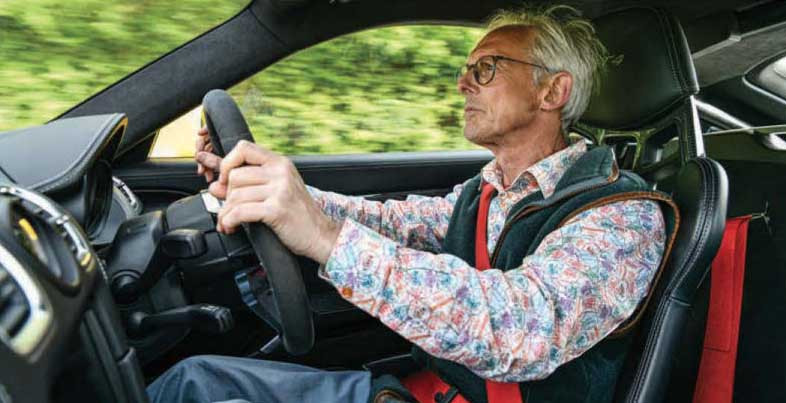
Take a look at the brand’s major successes at the race track and you’ll see mid-engined models reign supreme. There’s the 550 Spyder, of course, but also the 718 RSK, 904, 906, 910, 907, 908, 914, 917, 956, 962, 911 GT-1, RS Spyder and 919 Hybrid, to name but a few. How about the Carrera GT and 918 Spyder PHEV supercars? Mid-engined. I think I’ve made my point, but the long and short of it is that you need a damn good reason to buy a 911 in a world where the Cayman GT4 is up for grabs. In 981 guise, the GT4 presents 380bhp at 7,400rpm, bolstered by 310lb-ft torque. The sprint from rest to 62mph is nailed in 4.4 seconds, top speed is rated at 183mph. Equipped with a six-speed manual gearbox as standard and originally available with a wide range of optional extras, this generation of GT4 is currently one of the Porsche scene’s best buys — a scan of classifieds sees the price of entry to 981 GT4 ownership starting at less than sixty grand, rising to seventy-five for a low-mileage GT4 Clubsport kitted-out with Sport Chrono, satellite navigation, 918 Spyder carbon-fibre bucket seats and much more besides. It’s difficult to see what other sports car offers anything like the same level of engineering, performance and smiles to the mile at the same price point. Act fast, though, because values are only going one way.

If you like what the 981 GT4 offers as standard, you’ll be pleased to know there’s plenty of room for improvement, as the Racing Yellow example on these pages proves. The car is the pride and joy of Porschephile, Chris Whittle, who happens to be owner of the 944 Turbo Cup we featured on the cover of the January 2023 issue of 911 & Porsche World. Back in September 2015, he sold his Porsche Ceramic Composite Brakes (PCCB)-equipped Peridot Green 987 Cayman R and traded up for one of the first 981 GT4s sold in the UK. Since that time, he’s tweaked and tuned the not-so-mellow yellow coupe in a bid to refine and improve the recipe.
“Over the years, I’ve owned many fast 911s,” he says. “I find the Cayman’s front-to-back weight distribution far more forgiving than that of the 911, particularly on track when testing limits of adhesion.” His GT4 was carefully run-in, gradually building engine loading and revs, culminating with a change of engine and gearbox oil at two thousand miles.
ON THE RIGHT TRACK
As Chris’s ownership of a 944 Turbo Cup suggests, he is passionate about circuit driving. Unsurprisingly, it didn’t take long for the GT4 to make its debut in a motorsport environment. “Its first outing at Oulton Park felt good,” he remembers. “I gradually pushed the car more and more, turning in gently, earlier, whilst becoming more consistent.” On model launch, Porsche claimed the 981 GT4’s suspension to be fully adjustable, but as Chris quickly discovered, the range of configuration is insufficient to allow even wear of the front tyres during spirited driving. Indeed, at an eagerly anticipated outing to Spa-Francorchamps, where he expected the car’s tyres to last two days, he found himself shelling out for replacement rubber to due a section of the front nearside outer tread becoming separated from the tyre carcass. He was also dismayed to discover how rapidly PCCB pads wear. The choice was stark: continue driving the car in standard specification and suffer rapid tyre and pad wear or find alternative solutions.
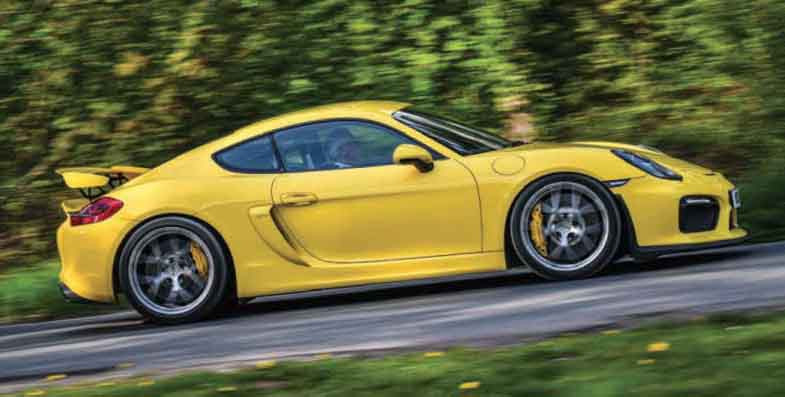
As someone who has participated in motorsport, he is no stranger to modifying Porsches. Long story short, he decided to reallocate his racing budget to developing his GT4 into what he thought the then mythical GT4 RS might have been. “I knew I’d forgo the car’s extended warranty, but I reasoned I could ‘self-insure’, allowing me to choose where and how to spend money on the car as I saw fit.” And so, the transformation began.
Despite Leeds-based marque specialist, Strasse, taking care of this 981’s servicing and maintenance requirements, Chris took the car to JZM Porsche (established in 1983 and an authorised agent for sales and installation of products from renowned Porsche tuner, Manthey-Racing) to address the regrettable front shoulder tyre wear and limited control he had over handling. “The JZM team fitted a Manthey-Racing suspension arm kit and KW Clubsport three-way passive dampers,” he explains. “With a ‘fast bump’ setting, the latter enables me to run more kerb, whilst being kinder to the chassis. The changes instantly made the car nimbler. I was delighted with the extra control at my disposal.”
Obviously, the harder the suspension, the harsher the ride. Helper springs ensured early suspension loading was supple and ensured the PCCB kit’s lower unsprung mass promoted better tyre contact with the surface beneath. Under heavy lateral forces (1.5g), the car continued to flat-track, but with minimum rebound, making transitions much smoother than when Porsche Active Suspension Management (PASM) system was in play.
The benefits were illustrated during a return visit to Oulton Park, where there is a dip on the left-hand side of the entrance to Cascades corner. “Under trail braking with PASM, the nearside tyre would chirrup,” Chris recalls. “It lost contact, then regained on turn-in. With the new dampers in place, silence. The confidence this provided was demonstrated at Donington, where the car was almost sliding through the circuit’s chicane, despite there being a crash barrier on the right and pit wall on the left!”
Having addressed handling, it was time to sort the brakes. “I was getting through PCCB pads much faster than I’d anticipated, as evidenced by the need for a second pad change at just 9,500 miles. PCCB makes use of a laminate structure. With heavy track use, heat tends to stay in the friction layer, transferring into the brake pad and causing accelerated wear.” This is a complaint aired by a high number of owners of Porsches equipped with PCCB, not least 911 & Porsche World contributor, Tim Harvey, whose 991 Gen II GT3 RS (featured on the cover of our April 2022 issue) was suffering from the same issue as the 981 GT4 on these pages. Both Tim and Chris found the solution in products manufactured by advanced braking equipment brand, Surface Transforms.
“I decided to replace the PCCB items with a set of Surface Transforms carbon-ceramic discs and pads, which run much cooler,” Chris reveals. Recognised for lasting twice as long as the PCCB components they replace and, importantly, costing significantly less than the Porsche parts, Surface Transforms braking equipment has become a staple of the high-performance Porsche scene. “The discs are long-fibre solid carbon-ceramic, dissipating heat throughout the disc itself, into the hub, carrier and wheel.” Moreover, a Surface Transforms disc can be skimmed, should it become warped or suffer abrasion.
Chris reports identical feel between PCCB and the Surface Transforms parts, which he commissioned Strasse to install. “It’s important to drive two cooling-down laps after each run and to jet-wash any dust out of the discs and calipers after each track day, else they feel dry and can be squeaky, but they have a feeling of unfadeable capacity.”
Some months after Strasse fitted the new discs and pads, Chris had the opportunity to compare their temperature performance with that of a friend’s iron-braked Cayman R at Oulton Park. The Porsches went out together for a fast session. After cooling-down, Chris used a pyrometer to compare the two systems. Whilst the experiment wasn’t entirely scientific, the results were astonishing — front/rear temperatures were 140°C/70°C for the Surface Transforms products, 175°C/225°C for the steels. “I can only imagine the Cayman R was making use of Porsche Stability Management (PSM), explaining the much higher rear disc temperature,” Chris reasons.
GOING THE DISTANCE
The modification has saved him the cost of many early pad changes and, importantly, the original PCCB discs (in excellent condition) are boxed-up, ready to reinstate, should he ever decide to sell the car. He estimates a set of PCCB pads would last three track days and set him back a thousand pounds, whereas a set of Surface Transforms pads will last at least ten track days. “The complete upgrade cost around ten grand, but on pad savings alone, I break even after about fifty trackdays.”
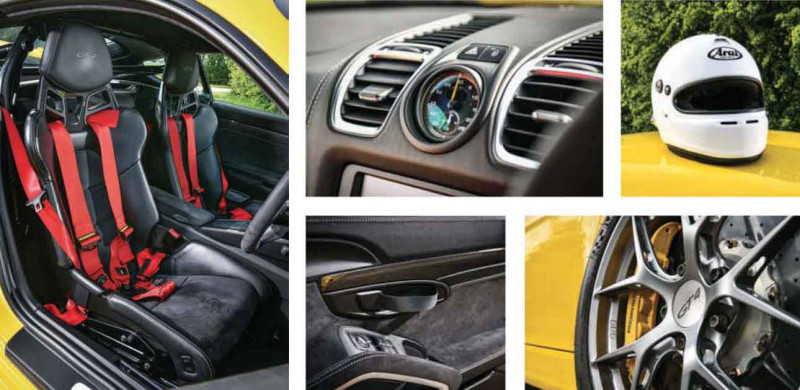
Scroll the clock forward two years and 8,500 miles of predominately track0oriented nirvana. Chris was still looking for ways to improve this eye-popping GT4. Porsche was muttering words to the effect of putting a GT4 RS into development, but there was no sign of a production date. With this in mind, come April 2019, he decided upon a further programme of modifications to bring his car as near as possible to the specification of a GT4 Clubsport, the somewhat confusing name for the not-street-legal 981 Cayman race car. His research took him to Germany, where Porsche tuner, Ehresmann Automotive, has built a solid reputation for successfully modifying Caymans (GT4s in particular).
Company boss, Jens Ehresmann, provided a bespoke and exceptional service, upgrading Chris’s GT4 with a Stage 3 power kit, including uprated exhaust headers with 200-cell catalysts, an IPD plenum with an 82mm throttle body, a BMC air filter, an M&M 2.5-inch non-valved exhaust with turn-down tips, ECU calibration and a Manthey-Racing GT4 Cup kit dialled in with hybrid fastroad/ track geometry.
Tuned and tested on the same type of MAHA dynamometer used by Porsche, the car registered in excess of 425bhp and 339.3lb-ft, a significant step up from factory specification and more than the Carrera GTS version of the first-generation 991. And in case you were wondering, there’s no chance of over-stressing the engine at this level of power, as Chris is keen to point out. “Don’t forget, this is the same 3.8-litre flat-six fitted to the 981 and 718 GT4 Clubsport race cars. Reliability is proven in race conditions, where the engines have been driven hard for three seasons without rebuild and, when opened up, require nothing more than the precautionary replacement of rings and bearings.”
Not long after model launch, controversy surrounding the 981 GT4’s six-speed manual gearbox emerged. The first examples of the breed (of which our feature car is one) had a splined shaft on certain gears, whereas later GT4 transmissions were assembled with welded gears. A defect resulted in ill-fated cars suffering transmission failure. An official recall was launched, notifying owners of the need to have these later gearboxes replaced under warranty. Porsche restricted the GT4’s standard torque output at 310lb-ft, but the transmission’s manufacturer says it is designed with a limit of closer to 405lb-ft. Needless to say, Chris’s car has proved faultless running the additional power afforded to it by the upgrades introduced at Ehresmann Automotive’s Dusseldorf base.
SHIFTING GROUND
“The extra flexibility and power shows in every mile this 981 drives,” he smiles. “Many people have said the GT4 is over-geared in standard trim, but my car’s additional torque, coupled with the smoother power curve and better breathing at the top end, has made this Porsche fizz with exuberance. The exhaust note is spine-tingling, even though it is three decibels quieter than the car’s original factory pipework. I never notice a gearing issue. If anything, there are times where the extra torque makes me lazily hold a lower gear, rather than working the upper ranges for that extra little bit of performance. This pays real dividends in less than perfect conditions, allowing the right foot to better test the available grip.”
Talking of which, a set of BBS FI-R forged alloy wheels and Michelin Pilot Sport Cup 2 black circles came next. A weight sample of a set of twenty-inch FI-Rs for the 911 Turbo and GT3 shows scales tipping at 7.9 kilograms for the front wheels and 9.3 kilos for the rears (nine and twelve inches wide respectively). Relief holes are machined directly into the classic Y-shaped spokes, helping make the FI-R lighter than the already featherweight BBS FI, but without losing structural integrity. “The saved fourteen kilos of unsprung mass complements the low mass of the carbon ceramic brake discs and the extra feel of the monoball suspension,” Chris continues. “I’m not saying this GT4 is now as fast as a GT3 RS, but it’s unquestionably more agile than a GT3. That said, the 991 GT3 features rear-wheel steering, which definitely helps.
Where my car excels, though, is where weight transfer is ordinarily a hindrance, rather than a help.”
Think tight corners with swift direction changes, dips and crests, such as those found at Cadwell Park, Zandvoort, Donington and Anglesey.

The car is fast approaching thirty thousand miles, but taking Chris’s heavy right foot into consideration, not to mention the high number of circuits this modified Cayman has become acquainted with over that distance, the fact it has required little more than regular oil and filter changes is testament to how robust the 981 GT4 platform really is. Put it this way, save for servicing, and with the exception of a replacement suspension arm (due to play) and a skim of the Surface Transform brake discs at the start of the year, this fantastic Porsche has only been subjected to work through its proud owner’s choice, rather than necessity.
As you’ve undoubtedly realised, he’s the kind of Porsche pilot always looking to find room for improvement. To this end, the car was recently treated to a low-ratio crown wheel and pinion kit, plus a lightweight clutch and flywheel, from independent Porsche sales, maintenance and tuning outfit, RPM Technik, resulting in improved acceleration and mid-range pick-up.
The company’s approach to developing the kit involved working with a world-renowned engineering firm recognised for supplying gears to the specialist automotive industry. The aim was to improve acceleration in all gears, with the option of a higher-ratio sixth for improved fuel economy and cruising comfort.
Across the previous pages, we’ve compared a base-model 981 Cayman with the equivalent 718. As alluded to in the article, and as a glance at any major car sales website will prove, sales of the turbocharged two-litre model aren’t exactly on fire right now, irrespective of how highly regarded this iteration of the four-cylinder coupe is by noted motoring hacks. There are myriad reasons for the entry-level 718’s poor performance on the used car marketplace, but arguments about engine noise and the huge tuning potential of the turbocharged 2.5-litre 718 Boxster/Cayman flat-four aside, even if you’re not a subscriber to the old adage, there ain’t no replacement for displacement, there’s every chance you simply can’t imagine owning a Porsche lacking the sound, smell and grunt of a normally aspirated flat-six.
Judging by Chris’s superb 981 GT4, plus the seemingly limitless number of tuning options available for enhancing this version of the Cayman far beyond factory prescribed performance, it’s easy to see why.
Above RPM Technik low-ratio crown wheel and pinion kit helps produce improved acceleration and mid-range pickup Facing page Minimum mass, maximum stability and wrapped in the world famous BBS Y-spoke design, lightweight forged alloy FI-R wheels look fantastic in place of the car’s stock rims

Below Chris has owned many interesting Porsches and counts a 944 Turbo Cup among his current fast fleet Above As the safety belts suggest, this is a GT4 used in anger at many of Europe’s best-loved circuits.
Above Lashings of Alcantara and carbonfibre 918 bucket seats mark this 981 as a sorted GT4 Below Surface Transforms brakes put paid to Chris having to frequently replace PCCB pads.
Above Chris’s intention was to make his GT4 as close to Clubsport spec as possible, whilst remaining road-legal. Below Mid-mounted engine is hidden, but benefits from a raft of upgrades, pushing power way beyond original specification.
Facing page We’ve yet to come across a Porsche which doesn’t look good in bright yellow paint
THE CAR REGISTERED IN EXCESS OF 425BHP AND 339.3LB-FT, A SIGNIFICANT STEP UP FROM FACTORY SPECIFICATION


